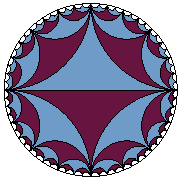Math 3320 - Introduction
to Number Theory
Fall 2011 |
Instructor: Allen Hatcher
- Office: 553 Malott Hall
- Phone: 255-4091
- Email:

- Office Hours:
- TA: Vikas Taliwal.
Textbook: We will be using a book I'm in the process of writing
which is available as a free download.
Exams: There will be one prelim and a final exam.
These will be take-home exams that you will have about a week to work on.
Prelim: Here is the take-home prelim, due Monday October 31. Here are solutions.
Final Exam: Here is the take-home final exam, due on Monday December 12.
Problem Sets: There will be one of these each week, usually.
- Problem Set #1, due Friday Sept 2. Solutions.
- Problem Set #2, due Friday Sept 9. Solutions.
- Problem Set #3, due Friday Sept 16. Solutions. To check your calculations, here is a continued fraction calculator.
- Problem Set #4, due Friday Sept 23. Solutions.
- Problem Set #5, due Friday Sept 30. Solutions.
- Problem Set #6, due Friday Oct 7. Solutions.
- Problem Set #7, due Monday October 17. Solutions.
- Problem Set #8, due Monday October 24. Solutions.
- Problem Set #9, due Friday November 4. Solutions.
- Problem Set #10, due Friday November 11. Solutions.
- Problem Set #11, due Monday November 21. Solutions.
- Problem Set #12, due Friday December 2. Solutions.
Grading: Most of your grade in the course will be based on
the exams. The approximate percentages
will be: final 50%, prelim 35%, and homework 15%.
About this course: This is one of the standard courses that
math majors can use for their algebra requirement, but a number of non-majors
take it too. Number Theory can be a fun subject! When I teach this course, I
do it a little differently from the usual introductory number theory course,
in that pictures and geometry will be used to illuminate algebraic concepts
and constructions whenever possible. Also some of the topics will be a little
different from what's standard. In particular we will not spend as much time
on congruences and modular arithmetic as is usual. (These topics and their applications
are covered more in Math 3360.)
Here is a tentative list of topics we will cover, but other things may be added
as time permits:
- Pythagorean Triples. As a warm-up for the main topics in the
course, we will look at integer solutions of the equation x^2 + y^2 = z^2,
where there is a nice geometric method for finding formulas giving all the
solutions.
 The Farey Diagram. This diagram, a miniature version of which is shown
at the right, gives a very nice way to picture things like the Euclidean algorithm
and continued fractions.
The Farey Diagram. This diagram, a miniature version of which is shown
at the right, gives a very nice way to picture things like the Euclidean algorithm
and continued fractions. - Quadratic Forms. Here we study quadratic forms ax^2 + bxy + cy^2
over the integers, following the approach of John Conway which uses the Farey
diagram to get a very beautiful and explicit picture of all the values of
the form, showing not just its qualitative features but also giving a method
for computing algorithmically.
- Quadratic Fields. Here the topic is extensions of the rational
numbers obtained by adjoining the square root of a positive or negative integer.
This sheds much light on the previous topic of quadratic forms, and vice versa.
It would take another semester to really get into the full theory of quadratic
fields, so this will be only an introduction, focusing on a few special cases
such as the Gaussian integers.
 The Farey Diagram. This diagram, a miniature version of which is shown
at the right, gives a very nice way to picture things like the Euclidean algorithm
and continued fractions.
The Farey Diagram. This diagram, a miniature version of which is shown
at the right, gives a very nice way to picture things like the Euclidean algorithm
and continued fractions.